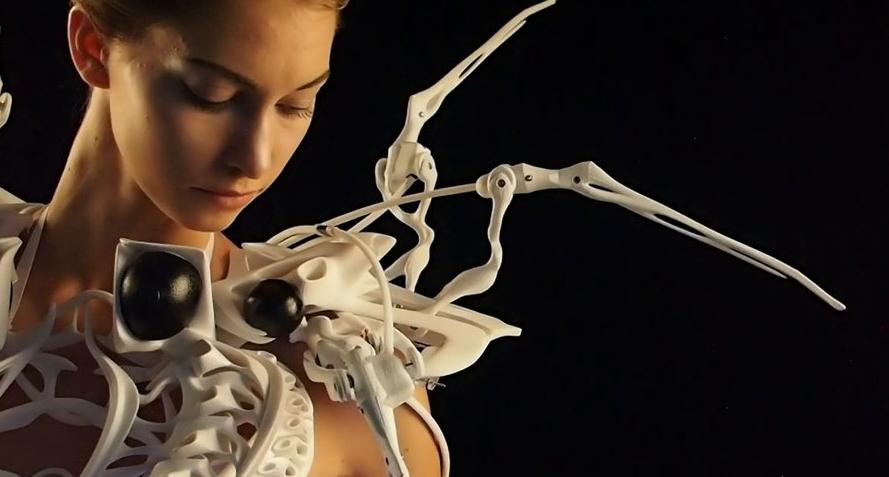If you don’t remember the stunning and technical work from Anouk Wipprecht—the Dutch fashion design working on “rethinking fashion in the age of digitalization” by combining engineering, fashion, robotics, science, and interaction/user experience in an emerging field known as FashionTech—let me refresh your memory. Noting that fashion lacks microcontrollers—something I never would have thought about—Wipprecht is an amazingly unique designer, who wants her clothing to, according to her website, “facilitate and augment the interactions we have with ourselves and our surroundings.”
“In a future where electronics are predicted to be embedded in everyday objects, – what kind of clothes will we wear? Will future techno fashion be purely aesthetic – or will it expand our awareness, acting like an intelligent second skin? Will we become super sensory, physically aware of data flows, communicating our internal states through the garments we wear? And, most pertinently perhaps, how will we socialize in our world when we are supervised by technology?”
Back in 2014, Wipprecht launched a campaign to create the first crowdsourced 3D-printed dress, and followed this up with her Synapse Dress, partnering with Materialise, Niccolo Casas, and Intel to create a wearable that leverages the wearer’s own electrical currents for a fully immersive experience. The designer later combined 3D printing with virtual reality to create a collection of dresses for Audi, and worked with model and musician Viktoria Modesta to fabricate 3D-printed prosthetics for musical performance.
Now, the high-tech futurist designer is back with two new 3D-printed wearables that could be very useful in this time of social distancing, due to the continuing COVID-19 crisis: the Proximity Dresses, Robotic Personal Space Defenders.
“Extending my research into proxemics and the body, I have fabricated two new dresses that create physical barriers when a person is detected in the immediate surroundings of the wearer,” Wipprecht said. “These twin dresses respond based on proximity and thermal sensors and indicates strangers within the intimate, personal, social and public space around the wearer.”
As with Wipprecht’s Smoke Dress and 3D-printed, robotic Spider Dress, which literally moves itself into an attack position if the embedded proximity biosensors detect that the wearer is uncomfortable, the design for these new dresses is based on Edward T. Hall’s Proxemics Theory. She explains that the theory defines “four spaces around the body,” each of which has its “own characteristic distances.”
“Whereas Hall had to measure the space between people using a wooden stick, I have been working since 2007 to translate these concepts into the digital domain, in order to measure the spaces between people up to a range of 25 feet,” she explained.
The Proximity Dresses use robotic, nylon 3D-printed hip mechanisms to extend when necessary. Additionally, they feature a transparent collar, 3D printed from clear resin, with some fancy sensors that offer noise-free distance readings.
These sensors use “high-output acoustic power combined with continuously variable gain, real-time background automatic calibration, real-time waveform signature analysis, and noise rejection algorithms. This holds true even in the presence of various acoustic or electrical noise sources, making it suitable for on-body use.”
By using the sensors, Wipprecht’s unique designs can invisibly trace their surroundings. Additionally, since the sensors don’t record any images or video, the dresses are not a threat to privacy, as nearby people remain anonymous.
“The Proximity Dress 2.0 is based on my 2012 prototype of this dress using hip mechanics create distance and a proximity sensor (ultrasonic rangefinder) for VW showcase during IAA, in Germany,” she concludes.
Check out the video below to see Wipprecht discuss her innovative, defensive Proximity Dress with Hyphen-Hub:
Discuss this story and other 3D printing topics at 3DPrintBoard.com or share your thoughts in the Facebook comments below.
The post Anouk Wipprecht’s 3D-Printed Proximity Dresses Are Perfect for Social Distancing appeared first on 3DPrint.com | The Voice of 3D Printing / Additive Manufacturing.




